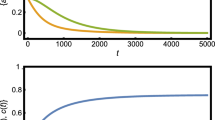Abstract.
The structured coalescent is used to calculate some quantities relating to the genealogy of a pair of homologous genes and to the degree of subpopulation differentiation, under a range of models of subdivided populations and assuming the infinite alleles model of neutral mutation. The classical island and stepping-stone models of population structure are considered, as well as two less symmetric models. For each model, we calculate the Laplace transform of the distribution of the coalescence time of a pair of genes from specified locations and the corresponding mean and variance. These results are then used to calculate the values of Wright’s coefficient F ST , its limit as the mutation rate tends to zero and the limit of its derivative with respect to the mutation rate as the mutation rate tends to zero. From this derivative it is seen that F ST can depend strongly on the mutation rate, for example in the case of an essentially one-dimensional habitat with many subpopulations where gene flow is restricted to neighbouring subpopulations.
Similar content being viewed by others
Author information
Authors and Affiliations
Additional information
Received: 1 October 1997 / Revised version: 15 March 1998
Rights and permissions
About this article
Cite this article
Wilkinson-Herbots, H. Genealogy and subpopulation differentiation under various models of population structure. J Math Biol 37, 535–585 (1998). https://doi.org/10.1007/s002850050140
Issue Date:
DOI: https://doi.org/10.1007/s002850050140




